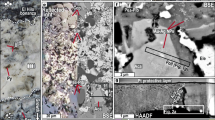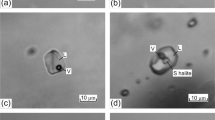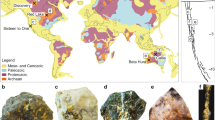Abstract
The origins of high-grade hydrothermal ore deposits are debated, but active geothermal systems provide important clues to their formation1,2. The highest concentrations of gold are found in geothermal systems with direct links to island arc magmatism3,4,5,6,7. Yet, similar concentrations have also been found in the absence of any input from arc magmas, for example, in the Reykjanes geothermal field, Iceland8. Here we analyse brine samples taken from deep wells at Reykjanes and find that gold concentrations in the reservoir zone have increased over the past seven years from an average of 3 ppb to 14 ppb. The metal concentrations greatly exceed the maximum solubility of gold in the reservoir under saturated conditions and are now nearly two orders of magnitude higher than in mid-ocean ridge black smoker fluids—the direct analogues of Reykjanes deep liquids8,9. We suggest that ongoing extraction of brine, the resulting pressure drop, and increased boiling have caused gold to drop out of solution and become trapped in the reservoir as a colloidal suspension. This process may explain how the stock of metal in the reservoirs of fossil geothermal systems could have increased over time and thus become available for the formation of gold-rich ore deposits.
This is a preview of subscription content, access via your institution
Access options
Subscribe to this journal
Receive 12 print issues and online access
$259.00 per year
only $21.58 per issue
Buy this article
- Purchase on Springer Link
- Instant access to full article PDF
Prices may be subject to local taxes which are calculated during checkout



Similar content being viewed by others
References
Henley, R. W. & Ellis, A. J. Geothermal systems ancient and modern: a geochemical review. Earth Sci. Rev. 18, 1–50 (1983).
McKibben, M. A. & Hardie, L. A. in Geochemistry of Hydrothermal Ore Deposits (ed. Barnes, H. L.) 877–935 (Wiley, 1997).
Simmons, S. F. & Browne, P. R. L. Hydrothermal minerals and precious metals in the Broadlands-Ohaaki geothermal system: implications for understanding low-sulfidation epithermal environments. Econ. Geol. 95, 971–999 (2000).
Simmons, S. F. & Brown, K. L. Gold in magmatic hydrothermal solutions and the rapid formation of a giant ore deposit. Science 314, 288–291 (2006).
Simmons, S. F. & Brown, K. L. The flux of gold and related metals through a volcanic arc, Taupo Volcanic Zone, New Zealand. Geology 35, 1009–1102 (2007).
Rae, A. J., Cooke, D. R. & Brown, K. L. The trace metal chemistry of deep geothermal water, Palinpinon Geothermal Field, Negros Island, Philippines: implications for precious metal deposition in epithermal gold deposits. Econ. Geol. 106, 1425–1426 (2001).
Hedenquist, J. W., Simmons, S. F., Giggenbach, W. F. & Eldridge, C. S. White Island, New Zealand, volcanic hydrothermal system represents the geochemical environment of high sulfidation Cu and Au ore deposition. Geology 21, 731–734 (1993).
Hardardóttir, V. et al. Metals in deep liquid of the Reykjanes geothermal system, southwest Iceland: implications for the composition of seafloor black smoker fluids. Geology 37, 1103–1106 (2009).
Hannington, M. D., de Ronde, C. E. J. & Petersen, S. 100th Anniversary Volume of Economic Geology 111–142 (Society of Economic Geologists, 2005).
Thorbjörnsson, D. et al. Reykjanes Conceptual Model Update to March 2014 Iceland Geosurvey Report ÍSOR 2014/049 1–60 (Iceland Geological Survey, 2014).
Lonker, S. W., Franzson, H. & Kristmannsdóttir, H. Mineral-fluid interaction in the Reykjanes and Svartsengi geothermal systems, Iceland. Am. J. Sci. 293, 605–670 (1993).
Fridriksson, Th. et al. CO2 emissions and heat flow through soil, fumaroles, and steam heated mud pools at the Reykjanes geothermal area, SW Iceland. Appl. Geochem. 21, 1551–1569 (2006).
Pope, E. C. et al. Isotopic constraints on ice age fluids in active geothermal systems: Reykjanes, Iceland. Geochim. Cosmochim. Acta 73, 4468–4488 (2009).
Óskarsson, F., Fridriksson, Th. & Thorbjörnsson, D. Proc. World Geotherm. Con. (International Geothermal Association, 2015).
Hardardóttir, V., Hannington, M., Hedenquist, J., Kjarsgaard, I. & Hoal, K. Cu-rich scales in the Reykjanes geothermal system, Iceland. Econ. Geol. 105, 1143–1155 (2010).
Brown, K. L. Gold deposition from geothermal discharges in New Zealand. Econ. Geol. 81, 979–983 (1986).
McKibben, M. E., Williams, A. E. & Hall, G. E. M. Solubility and transport of platinum-group elements and Au in saline hydrothermal fluids: constraints from geothermal brine data. Econ. Geol. 85, 1926–1934 (1990).
Gallup, D. L. Geochemistry of geothermal fluids and well scales, and potential for mineral recovery. Ore Geol. Rev. 12, 225–236 (1998).
Brown, K. L. & Simmons, S. F. Precious metals in high-temperature geothermal systems in New Zealand. Geothermics 32, 619–625 (2003).
Benning, L. G. & Seward, T. M. Hydrosulphide complexing of Au (I) in hydrothermal solutions from 150–400 °C and 500–1500 bar. Geochim. Cosmochim. Acta 60, 1849–1871 (1996).
Stefannson, A. & Seward, T. M. Gold (I) complexing in aqueous sulphide solutions to 500 °C at 500 bar. Geochim. Cosmochim. Acta 68, 4121–4143 (2004).
German, C. R. & Von Damm, K. L. in Treatise on Geochemistry Vol. 6 (eds Holland, H. D. & Turekian, K. K.) 181–222 (Elsevier, 2006).
Brown, K. L. Kinetics of gold precipitation from experimental hydrothermal sulfide solutions. Econ. Geol. Monograph 6, 320–327 (1989).
Williams-Jones, A. E., Bowell, R. J. & Migdisov, A. A. Gold in solution. Elements 5, 281–287 (2009).
Saunders, J. A. Colloidal transport of gold and silica in epithermal precious metal systems: evidence from the Sleeper deposit, Humboldt County, Nevada. Geology 18, 757–760 (1990).
Hough, R. M., Noble, R. R. P. & Reich, M. Natural gold nanoparticles. Ore Geol. Rev. 42, 55–61 (2011).
Herrington, R. J. & Wilkinson, J. J. Colloidal gold and silica in mesothermal vein systems. Geology 21, 539–542 (1993).
Ingebritsen, S. E. Modeling the formation of porphyry-copper ores. Science 338, 1551–1552 (2012).
Webber, A. P., Roberts, S., Taylor, R. N. & Pitcairn, I. K. Golden plumes: substantial gold enrichment of oceanic crust during ridge-plume interaction. Geology 41, 87–90 (2013).
Rubin, K. Degassing of metals and metalloids from erupting seamount and mid-ocean ridge volcanoes: observations and predictions. Geochim. Cosmochim. Acta 61, 3525–3542 (1997).
Acknowledgements
We thank ÍSOR and HS Orka Ltd for field support during the sampling of RN-12, 19, and 21. Financial support for this work was provided by HS Orka Ltd and by GEOMAR − Helmholtz Centre for Ocean Research Kiel and an NSERC Discovery grant to M.H. F. Óskarsson, G. Ó. Friðleifsson and B. Steingrímsson are thanked for their helpful discussions during the sampling and for insight on the discharge history of the wells. M. Olafsson assisted with the collection of the surface samples. U. Westernströer and K. Bremer assisted with the trace metal analyses.
Author information
Authors and Affiliations
Contributions
All authors participated in the fieldwork, the design of the study, and the analysis of the data. M.H. and V.H. prepared the manuscript with D.G.-S. and K.L.B. The sampling programme was managed by V.H., together with ÍSOR and HS Orka staff. K.L.B. provided the downhole sampler and oversaw the deployments. D.G.-S. conducted the laboratory analyses. All authors discussed the results and contributed to the writing of the paper.
Corresponding author
Ethics declarations
Competing interests
The authors declare no competing financial interests.
Supplementary information
Supplementary Information
Supplementary Information (PDF 929 kb)
Rights and permissions
About this article
Cite this article
Hannington, M., Harðardóttir, V., Garbe-Schönberg, D. et al. Gold enrichment in active geothermal systems by accumulating colloidal suspensions. Nature Geosci 9, 299–302 (2016). https://doi.org/10.1038/ngeo2661
Received:
Accepted:
Published:
Issue Date:
DOI: https://doi.org/10.1038/ngeo2661
This article is cited by
-
A track record of Au–Ag nanomelt generation during fluid-mineral interactions
Scientific Reports (2023)
-
The behaviour of metals in deep fluids of NE Iceland
Scientific Reports (2022)
-
Scanning-electron-microscope imaging of gold (electrum) nanoparticles in middle Miocene bonanza epithermal ores from northern Nevada, USA
Mineralium Deposita (2020)
-
Seawater-dominated, tectonically controlled and volcanic related geothermal systems: the case of the geothermal area in the northwest of the island of Euboea (Evia), Greece
International Journal of Earth Sciences (2020)
-
Colloidal gold transport: a key to high-grade gold mineralization?
Mineralium Deposita (2020)



